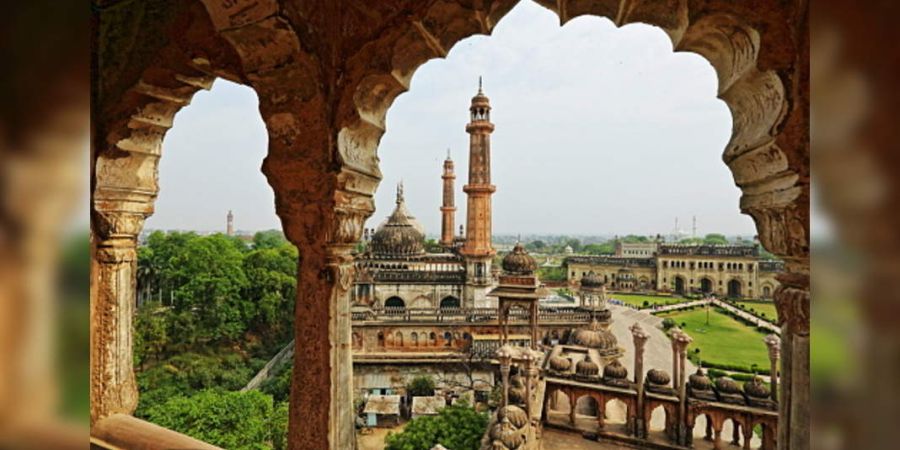

The north Indian state of Uttar Pradesh is one of the last bastions of feudal life left on the whole of the subcontinent. The centuries melt away here to a gentler, more poetic age. Villagers and princes alike still speak of the 1857 uprising as though it were a recent happening and ancestors’ exploits are recounted with detailed gusto. The old kingdom of Awadh was a place of high Urdu culture and the heartland of Sufism, a mystical branch of Islam. Shards of the courtly rituals survive behind peeling facades emblazoned with scaled fish, the symbol of the region.
A mango-grove-lined drive from the state capital, Lucknow, leads to the long-jilted palace of Bilehra. The building is one of India’s most striking examples of Indo-European Regency architecture, whose simple lines preceded the more belligerent Indo-Gothic style. It has lain more or less untouched since the demise of the last raja of Bilehra, Abul Hasan Khan, in the Spanish flu pandemic of 1918. The flu had also claimed the life of his eight-year-old heir only a few months prior; family lore has the father actually dying of a broken heart. Three young daughters were left as sole heiresses to one of the oldest Shia dynasties in the country. The British circled, ready to assume control of the estate as a ward of court, before a plot was hatched to see them off.
The elder daughter, Kaniz Abid, became rani of Bilehra in her own right. Through marriage with her cousin, she shored up the family line by uniting it with the powerful neighbouring rajas of Mahmudabad, while also halting any British claim to Bilehra. The present custodian is her only son, the 77-year-old Raja Mohammad Amir Mohammad Khan, who movingly describes first seeing his maternal inheritance as we wander through the palace together. “I did not step through the gates until 1973, aged 29, despite growing up just an hour away,” he says. “My mother, due to superstition and, perhaps, long-held remorse over her family’s misfortune, had never wanted me to visit the place. But, as I stood in the shadowy durbar hall, I was overcome with a sense of coming home.”


SUBSCRIBE
uttar-pradesh-Bilehra-Palace-photos
Uttar Pradesh: The Bilehra Palace remains one of India’s most striking examples of Indo–European regency architecture
The palace's simple lines preceded the more belligerent Indo–gothic style. It has, as this writer discovers, lain almost untouched since 1918
Cosmo Brockway
James Mcdonald
APRIL 2, 2021 9:00 AM
The north Indian state of Uttar Pradesh is one of the last bastions of feudal life left on the whole of the subcontinent. The centuries melt away here to a gentler, more poetic age. Villagers and princes alike still speak of the 1857 uprising as though it were a recent happening and ancestors’ exploits are recounted with detailed gusto. The old kingdom of Awadh was a place of high Urdu culture and the heartland of Sufism, a mystical branch of Islam. Shards of the courtly rituals survive behind peeling facades emblazoned with scaled fish, the symbol of the region.
A mango-grove-lined drive from the state capital, Lucknow, leads to the long-jilted palace of Bilehra. The building is one of India’s most striking examples of Indo-European Regency architecture, whose simple lines preceded the more belligerent Indo-Gothic style. It has lain more or less untouched since the demise of the last raja of Bilehra, Abul Hasan Khan, in the Spanish flu pandemic of 1918. The flu had also claimed the life of his eight-year-old heir only a few months prior; family lore has the father actually dying of a broken heart. Three young daughters were left as sole heiresses to one of the oldest Shia dynasties in the country. The British circled, ready to assume control of the estate as a ward of court, before a plot was hatched to see them off.
The elder daughter, Kaniz Abid, became rani of Bilehra in her own right. Through marriage with her cousin, she shored up the family line by uniting it with the powerful neighbouring rajas of Mahmudabad, while also halting any British claim to Bilehra. The present custodian is her only son, the 77-year-old Raja Mohammad Amir Mohammad Khan, who movingly describes first seeing his maternal inheritance as we wander through the palace together. “I did not step through the gates until 1973, aged 29, despite growing up just an hour away,” he says. “My mother, due to superstition and, perhaps, long-held remorse over her family’s misfortune, had never wanted me to visit the place. But, as I stood in the shadowy durbar hall, I was overcome with a sense of coming home.”
uttar-pradesh-Bilehra-Palace-photos
Once scene of coronations, the durbar hall would have been hung with a forest of chandeliers
uttar-pradesh-Bilehra-Palace-photos
This anteroom is a blaze of turquoise and brick-red Islamic and European stencilled motifs
uttar-pradesh-Bilehra-Palace-photos
This study in the Bilehra Palace is a riot of blue-green painted plasterwork against the palest pink distemper
uttar-pradesh-Bilehra-Palace-photos
The imambara as seen from the palace’s upper gallery
At that time, the main rooms of the palace had not been used since the flu scourge of 1918. The redoubtable rani would stay in the zenana, or women’s quarters, on her annual visits, a chalky warren of austere chambers with muslin drapes fluttering across the doors into courtyards worn smooth by generations of purdah. A place of honour and storytelling, the zenana still holds the untouched bedroom of the late rani, who would travel from her married home to Bilehra in a palanquin, even in the 1960s, held aloft by four men and a mounted guard. “As the party reached her realm, my mother’s palanquin would be laid on the side of the road,” remembers the Raja. “She would lift the embroidered curtain to gaze across the orchards and rivers with tearful pride and


